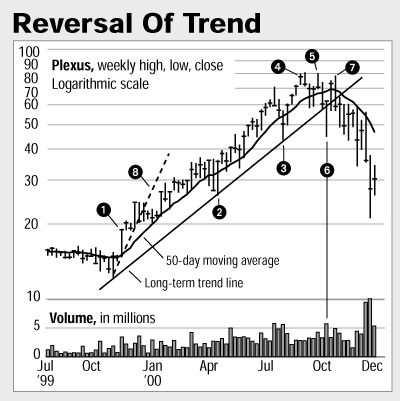
INVESTOR'S BUSINESS DAILY
Fall a little, rise a lot. Fall a little more, rise a lot more. A good stock acts this way after it breaks out. Trend lines can help you spot when the pattern changes.
As always, keeping a list of good sell rules is the best way to reap the most gains from your winners. But if you're not sure whether a stock is in real trouble, see if it breaks below an upward trend line. If so, you'll have greater reason and confidence to sell before your winner sinks fast and eats your gains.
To draw a trend line, connect at least three lows, each higher than the previous one, on a weekly chart. As the first point, use the stock's low just before it breaks out. The line must cover at least several months. If you draw it over too brief a period, the stock may cut below it during a normal correction, forcing you to sell too early.
Plexus vaulted out of a long base on Nov. 16, 1999 (see point 1 in accompanying image), a few weeks after the market turned. (The chart doesn't show the entire base.) It cruised past its pivot of 16.30 and sped up 32% on seven straight days of big volume. Plexus belonged to the hot chipmaker group, ranked No. 12 among the 197 IBD industry groups.
The contract electronics maker doubled by late March. Then the market topped. Biotechs and Internets tanked. It looked like Plexus would fall hard, too. In mid-April, it slumped below its 50-day moving average on heavy trade and sank 30% below its high (point 2).

Given the rough market, it would have been totally acceptable to sell Plexus and lock in a good gain. Yet as other techs dropped 50% to 80% from their highs, Plexus somehow climbed back above its 50-day on April 18 and rallied. If it failed to stay above its 50-day, you had to sell. Instead, it showed strength. Its April 17 low became the second point of a long-term trend line.
Plexus crossed its 50-day two more times in May, but rebounded and struck new highs on heavy volume. From late July, the stock fell for three straight weeks on heavy trade. Yet on the third week, note how it finished in the upper half of its range (point 3). This was the trend line's third point.
The stock made new highs on high volume in late August. But on Aug. 31 and Sept. 1, it notched new highs on light trade, a key sell signal (point 4). Four weeks later in late September, it failed to hit a new high (point 5).
In mid-October, Plexus dived as much as 26% in a week and cut below its trend line (point 6). Meanwhile, the Nasdaq's rally that started in late May lost steam. It posted five distribution days from Sept. 5 to 15 — a third bad sign. It was time to sell. Plexus once again tried to hit a new high, but failed in late October (point 7). It also couldn't get back above its 50-day. The stock slid fast. By late December, it dropped as low as 21.13, off 74% from its peak of 81.
It takes practice to use trend lines correctly. If you draw them too tightly (point 8), you might forfeit a large amount of potential gains.